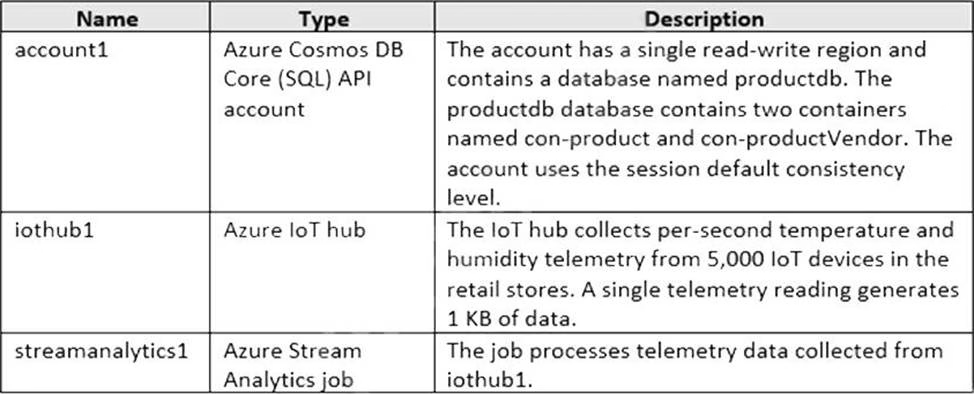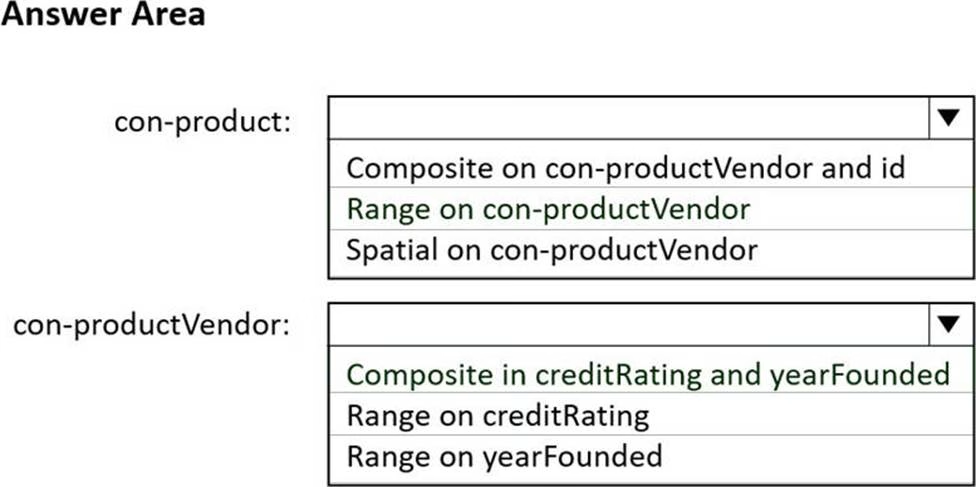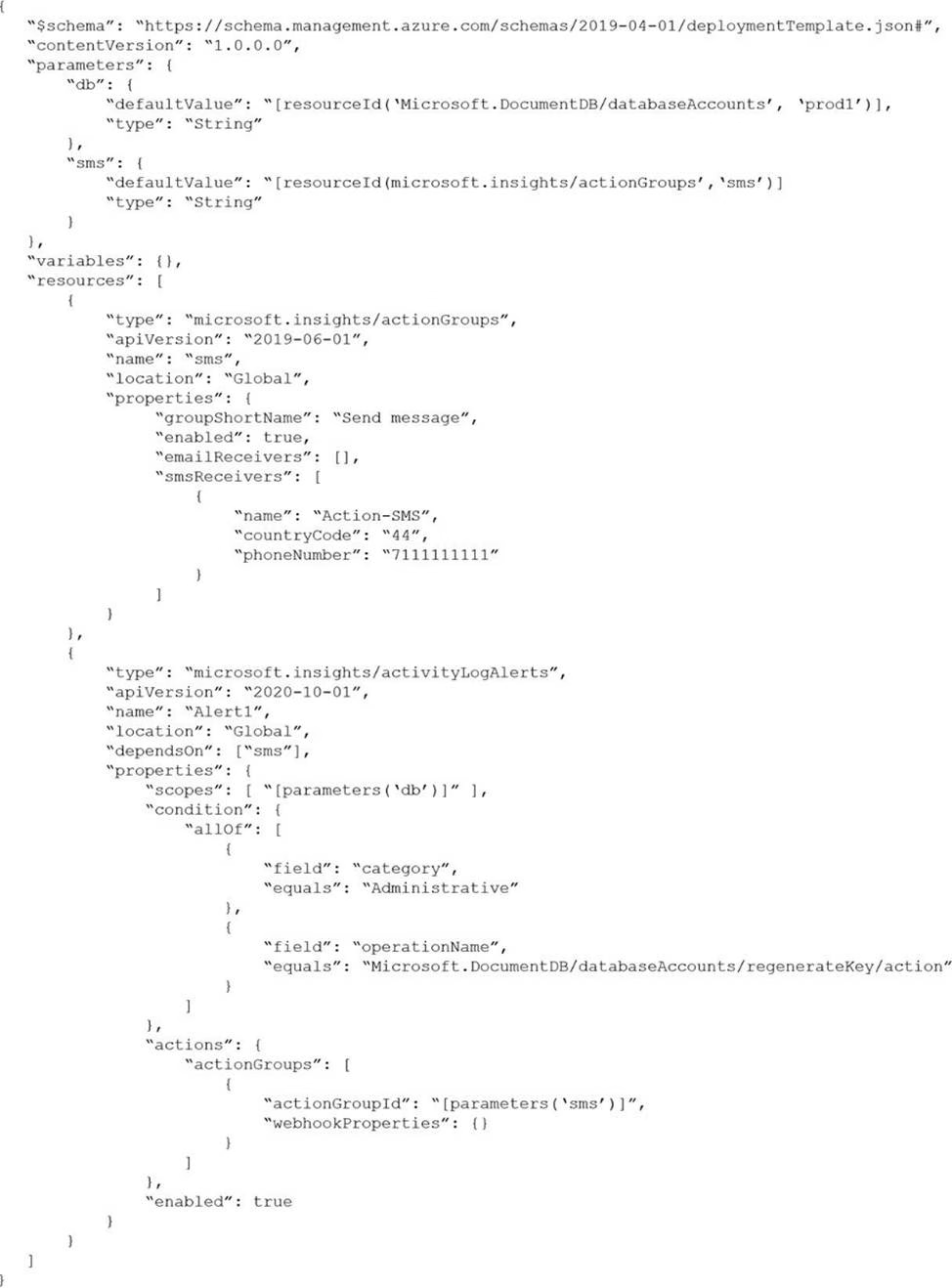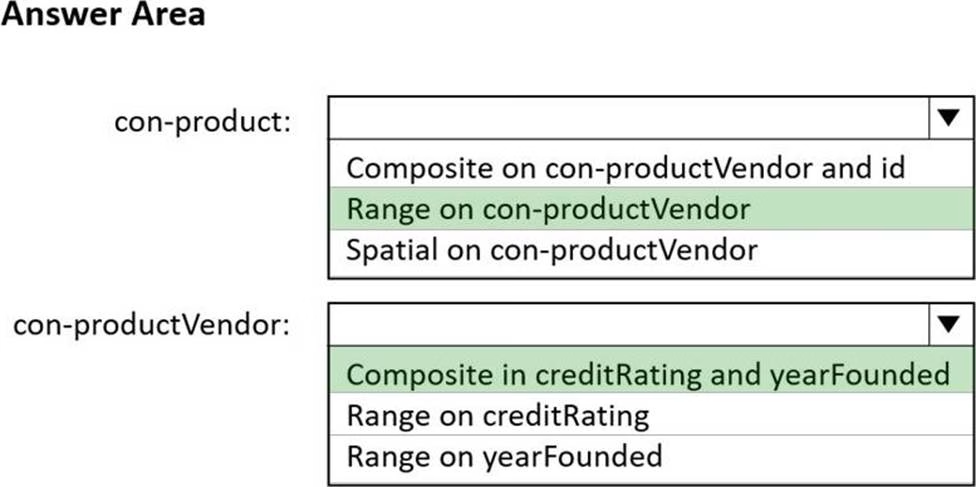Microsoft DP-420 Designing and Implementing Cloud-Native Applications Using Microsoft Azure Cosmos DB Online Training
Microsoft DP-420 Online Training
The questions for DP-420 were last updated at Apr 14,2025.
- Exam Code: DP-420
- Exam Name: Designing and Implementing Cloud-Native Applications Using Microsoft Azure Cosmos DB
- Certification Provider: Microsoft
- Latest update: Apr 14,2025
Topic 1: Litware, inc
Case Study
This is a case study. Case studies are not timed separately. You can use as much exam time as you would like to complete each case. However, there may be additional case studies and sections on this exam. You must manage your time to ensure that you are able to complete all questions included on this exam in the time provided.
To answer the questions included in a case study, you will need to reference information that is provided in the case study. Case studies might contain exhibits and other resources that provide more information about the scenario that is described in the case study. Each question is independent of the other questions in this case study.
At the end of this case study, a review screen will appear. This screen allows you to review your answers and to make changes before you move to the next section of the exam. After you begin a new section, you cannot return to this section.
To start the case study
To display the first question in this case study, click the Next button. Use the buttons in the left pane to explore the content of the case study before you answer the questions. Clicking these buttons displays information such as business requirements, existing environment, and problem statements. If the case study has an All Information tab, note that the information displayed is identical to the information displayed on the subsequent tabs. When you are ready to answer a question, click the Question button to return to the question.
Overview
Litware, Inc. is a United States-based grocery retailer. Litware has a main office and a primary datacenter in Seattle. The company has 50 retail stores across the United States and an emerging online presence. Each store connects directly to the internet.
Existing environment. Cloud and Data Service Environments.
Litware has an Azure subscription that contains the resources shown in the following table.

Each container in productdb is configured for manual throughput.
The con-product container stores the company’s product catalog data. Each document in con-product includes a con-productvendor value. Most queries targeting the data in con-product are in the following format.
SELECT * FROM con-product p WHERE p.con-productVendor – ‘name’
Most queries targeting the data in the con-productVendor container are in the following format
SELECT * FROM con-productVendor pv
ORDER BY pv.creditRating, pv.yearFounded
Existing environment. Current Problems.
Litware identifies the following issues:
Updates to product categories in the con-productVendor container do not propagate automatically to documents in the con-product container.
Application updates in con-product frequently cause HTTP status code 429 "Too many requests". You discover that the 429 status code relates to excessive request unit (RU) consumption during the updates.
Requirements. Planned Changes
Litware plans to implement a new Azure Cosmos DB Core (SQL) API account named account2 that will contain a database named iotdb. The iotdb database will contain two containers named con-iot1 and con-iot2.
Litware plans to make the following changes:
Store the telemetry data in account2.
Configure account1 to support multiple read-write regions.
Implement referential integrity for the con-product container.
Use Azure Functions to send notifications about product updates to different recipients. Develop an app named App1 that will run from all locations and query the data in account1. Develop an app named App2 that will run from the retail stores and query the data in account2. App2 must be limited to a single DNS endpoint when accessing account2.
Requirements. Business Requirements
Litware identifies the following business requirements:
Whenever there are multiple solutions for a requirement, select the solution that provides the best performance, as long as there are no additional costs associated. Ensure that Azure Cosmos DB costs for IoT-related processing are predictable.
Minimize the number of firewall changes in the retail stores.
Requirements. Product Catalog Requirements
Litware identifies the following requirements for the product catalog:
Implement a custom conflict resolution policy for the product catalog data.
Minimize the frequency of errors during updates of the con-product container.
Once multi-region writes are configured, maximize the performance of App1 queries against the data in account1.
Trigger the execution of two Azure functions following every update to any document in the con-product container.
You are troubleshooting the current issues caused by the application updates.
Which action can address the application updates issue without affecting the functionality of the application?
- A . Enable time to live for the con-product container.
- B . Set the default consistency level of account1 to strong.
- C . Set the deault consistency level of account1 to bounded staleness.
- D . Add a custom indexing policy to the con-product container.
You need to select the partition key for con-iot1. The solution must meet the IoT telemetry requirements.
What should you select?
- A . the timestamp
- B . the humidity
- C . the temperature
- D . the device ID
You need to identify which connectivity mode to use when implementing App2. The solution must support the planned changes and meet the business requirements.
Which connectivity mode should you identify?
- A . Direct mode over HTTPS
- B . Gateway mode (using HTTPS)
- C . Direct mode over TCP
You configure multi-region writes for account1.
You need to ensure that App1 supports the new configuration for account1. The solution must meet the business requirements and the product catalog requirements.
What should you do?
- A . Set the default consistency level of accountl to bounded staleness.
- B . Create a private endpoint connection.
- C . Modify the connection policy of App1.
- D . Increase the number of request units per second (RU/s) allocated to the con-product and con-productVendor containers.
You need to provide a solution for the Azure Functions notifications following updates to con-product. The solution must meet the business requirements and the product catalog requirements.
Which two actions should you perform? Each correct answer presents part of the solution. NOTE: Each correct selection is worth one point.
- A . Configure the trigger for each function to use a different leaseCollectionPrefix
- B . Configure the trigger for each function to use the same leaseCollectionNair.e
- C . Configure the trigger for each function to use a different leaseCollectionName
- D . Configure the trigger for each function to use the same leaseCollectionPrefix
You need to implement a solution to meet the product catalog requirements.
What should you do to implement the conflict resolution policy.
- A . Remove frequently changed field from the index policy of the con-product container.
- B . Disable indexing on all fields in the index policy of the con-product container.
- C . Set the default consistency level for account1 to eventual.
- D . Create a new container and migrate the product catalog data to the new container.
HOTSPOT
You need to recommend indexes for con-product and con-productVendor. The solution must meet the product catalog requirements and the business requirements.
Which type of index should you recommend for each container? To answer, select the appropriate options in the answer area. NOTE: Each correct selection is worth one point.

HOTSPOT
You need to select the capacity mode and scale configuration for account2 to support the planned changes and meet the business requirements.
What should you select? To answer, select the appropriate options in the answer area. NOTE: Each correct selection is worth one point.

Topic 2, Misc. Questions
You have an application named App1 that reads the data in an Azure Cosmos DB Core (SQL) API account. App1 runs the same read queries every minute. The default consistency level for the account is set to eventual.
You discover that every query consumes request units (RUs) instead of using the cache.
You verify the IntegratedCacheiteItemHitRate metric and the IntegratedCacheQueryHitRate metric.
Both metrics have values of 0.
You verify that the dedicated gateway cluster is provisioned and used in the connection string.
You need to ensure that App1 uses the Azure Cosmos DB integrated cache.
What should you configure?
- A . the indexing policy of the Azure Cosmos DB container
- B . the consistency level of the requests from App1
- C . the connectivity mode of the App1 CosmosClient
- D . the default consistency level of the Azure Cosmos DB account
HOTSPOT
You provision Azure resources by using the following Azure Resource Manager (ARM) template.

For each of the following statements, select Yes if the statement is true. Otherwise, select No. NOTE: Each correct selection is worth one point.

Latest DP-420 Dumps Valid Version with 51 Q&As
Latest And Valid Q&A | Instant Download | Once Fail, Full Refund




